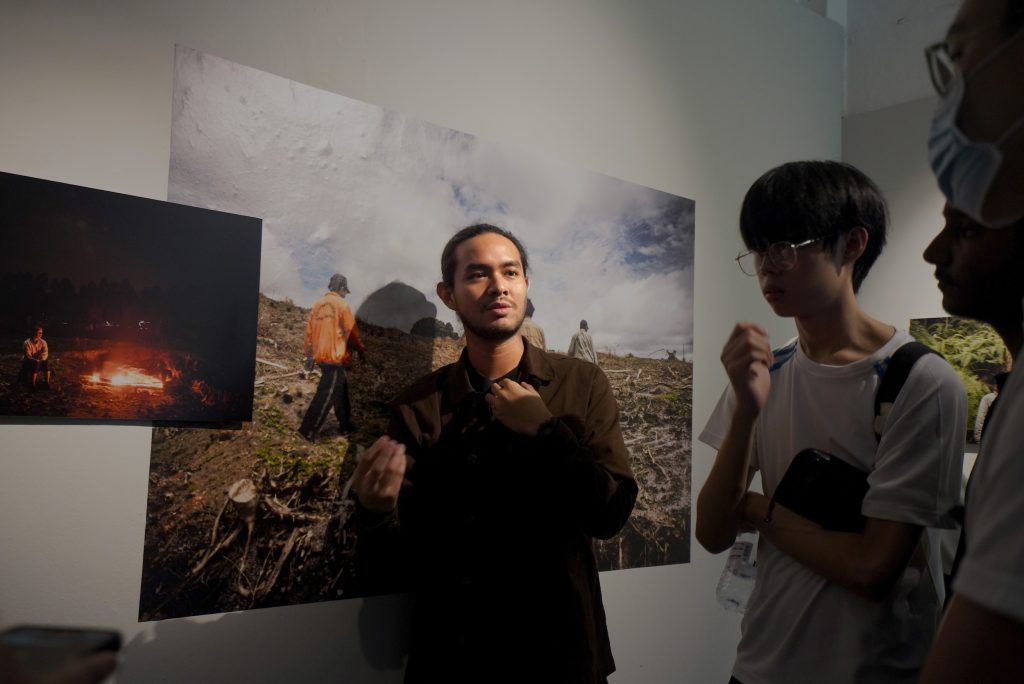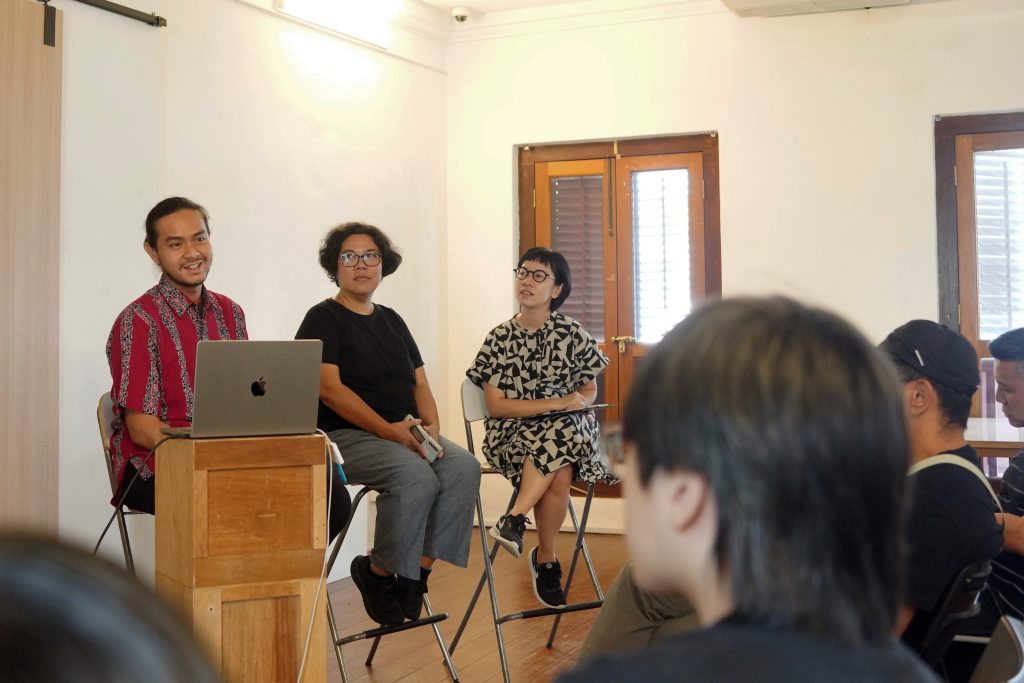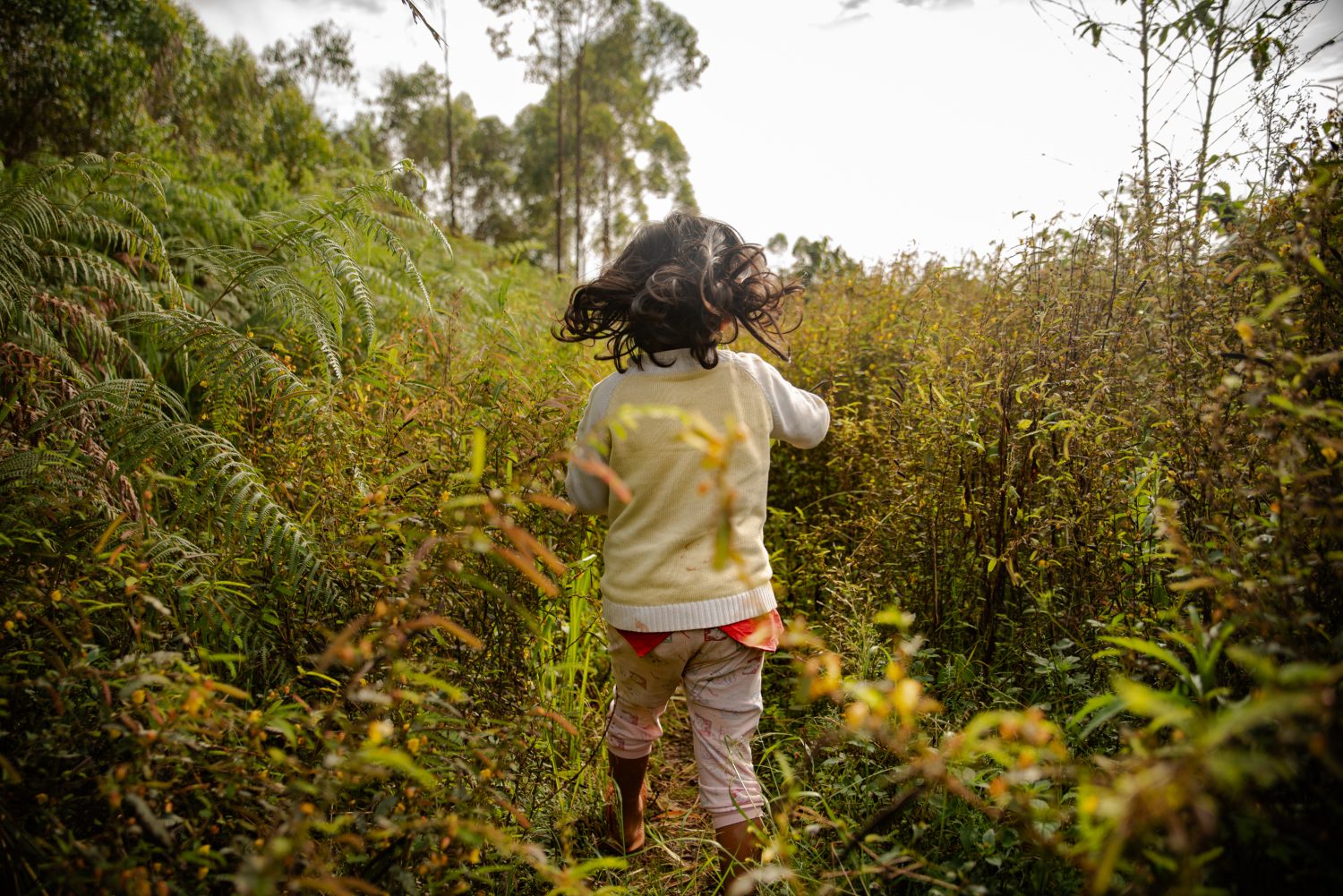A Conversation with Kaleb Sitompul and Ng Swan Ti on ‘Mangaramoti Tano Ni Ompung (To Bless the Mother’s Land)’
Indonesian photographer, Kaleb Sitompul, recipient of the Objectifs Documentary Award 2023 (Emerging Category), presented his exhibition, Mangaramoti Tano Ni Ompung (To Bless the Mother’s Land), at Objectifs from 18 May to 16 June 2024. Mentored by Ng Swan Ti, Kaleb’s show highlighted the Natinggir Forest Indigeneous Community’s struggle to preserve their ancestral lands.
The following recap presents highlights from Kaleb and Swan Ti’s conversation about the process and considerations that went into Mangaramoti Tano Ni Ompung (To Bless the Mother’s Land). The session was moderated by Chelsea Chua, Objectifs’ Programme Director. This recap has been paraphrased and shortened for brevity.
On Kaleb’s motivations and journey as a documentary photographer
Having wanted to be a photojournalist since young, Kaleb started his talk outlining the challenges he initially faced in his pursuit. As the only son in a family with Batak lineage, he was shouldered with the responsibilities and expectations that came with his position. With his parents unwilling to consider photojournalism as a ‘coveted’ job, he practised photography on his own as a hobby up till 2012.
Upon graduating high school, and with his parents still in disagreement with his desire to pursue photography, Kaleb decided to enrol in filmmaking studies at the Jakarta Institute of Art as a way to continue learning how to handle camera equipment.
Acknowledging the difficulties of breaking into the highly competitive Indonesian film industry, which heavily depended on who you know as much as what you know, Kaleb finally managed to convince his parents to give him their blessings for his transition to photography after completing his film studies. Promising to keep them constantly updated on his progress, he struck an agreement with them to get a ‘traditional’ job should he do poorly at his one-year mentorship at the Pannafoto Institute.

On Kaleb’s start at Pannafoto Institute
Proudly mentioning that Pannafoto Institute was a huge turning point in his life and career, Kaleb stated that it was at the Institute where he met many other artists, photographers, and mentors who provided a safe space to have important conversations on how to be a photographer in Indonesia. It was also at Pannafoto Institute that he realised he really wanted to become a storyteller using the medium of photography. More importantly, he eventually discovered that he had a knack for it.
Honing his craft and skills at being a storyteller, however, still took time and experience. At the Institute, he received advice from his first mentor to focus on the stories that really mattered to him. Inclined to think about his childhood and how he loved to spend his younger days at Lake Toba, Kaleb had found it difficult to weave a story about it from scratch. Encouraged further by his mentor to simply make a trip back to Lake Toba itself with his camera and look for stories he wanted to tell, it was then that he discovered how the people living at Lake Toba had been having increasing difficulties sourcing for fresh water. Intrigued by how the waters had become poisoned over the years from various sources, the hardship faced by the people of Lake Toba became Kaleb’s first project.
With his second mentor asking him to focus on heritage, Kaleb made the call to drop everything that he was doing in Jakarta to return to Medan again, where he was also unexpectedly contacted by friends telling him about the growing destruction of frankincense trees in Toba, an important resource for the Batak tribe in that area. Asked to write about the issue, he decided to pursue research in this area, despite initially feeling under-equipped to do so as he had no prior experience as a journalist, and did not know how it would be like finding himself in the middle of a ‘conflict zone’ that was taking place between the tribe and the companies of the encroaching eucalyptus plantations. To his surprise, when he returned to Toba, he found himself being treated like a son whom the inhabitants looked up to because of the work that he had done previously about its famous lake. Chiming in at this point, Swan Ti also mentioned that she found Kaleb’s work interesting due to his own ties to his subjects because of their shared lineage, thus allowing him to use photography as a means to explore his own identity too.
Working on Mangaramoti Tano Ni Ompung (To Bless the Mother’s Land) and the mentorship experience
Because of the remoteness of the area, the villagers were not well-acquainted with photography, which resulted in Kaleb showing them projections of his latest projects at the very start to give them an idea of what he would be working on, for and with them.
“I can be here because of their stories,” he remarked, and explained that through this project, his perspective as a photographer started to shift because he wanted to approach the community and his subjects in a different manner. He wanted to feel what his subjects felt regarding the issue at hand. Mangaramoti Tano Ni Ompung (To Bless the Mother’s Land) eventually made him see his role as an artist and a photographer who shared about these extremely important stories in order to give voice to those who may not have the means or ways to do so themselves.
Through the mentorship experience – one of the focal highlights for recipients of the Objectifs Documentary Award – Swan Ti also managed to help Kaleb work on capturing his subjects’ perspective so that the project would articulate the story that needed to be told. “There is a responsibility as a photographer to stay true to the subjects’ stories and bring these stories to various audiences. The most important discussion we had was about the role of the photographer in such projects,” she commented.
Admitting that he was initially very stressed out by the mentorship because he saw their discussions as assignments with specific outcomes, Kaleb could only ask himself questions such as “What am I going to shoot here? What should I do now?” in September 2023. Upon seeing his first round of photos, Swan Ti could also tell that he was extremely stressed out, as he only took photographs that were based on his brief with her. She encouraged him to enjoy the process instead, and that it was alright for him to just feel his way around things first before figuring them out later.
Flying back to Jakarta in March 2024, both of them worked together to trim the 500 photos that Kaleb had to just 15 photos for the exhibition. “There is a need to ‘kill [one’s] darlings’ in order to tell the story that is most true, and most important,” Swan Ti said. Commenting further on the mentorship process, she brought up her belief in photographs reflecting the photographer’s self, as well as their sense of respect towards their subjects. She understood that Kaleb felt the pressure to prove himself, and thus she wanted to encourage his knack for photojournalistic images. “I wanted him to feel the nature,” she said, having told him to take even photographs that he might not feel would be of immediate importance while he was onsite. Going through every frame with him while they were doing the editing and sequencing, they then proceeded to consult Chelsea to get her expertise and final touch as she had a better understanding of the exhibiting space.

Further considerations and long-term plans for the project
Highlighting the fact that Kaleb would have faced some pressure presenting this exhibition in Singapore because the community here might not be familiar with, or feel for the topics that he was presenting, Chelsea asked how this affected his and Swan Ti’s considerations for the project. Kaleb explained that he did this by appealing to the universal understanding of how one would feel to have their own living space and community taken away. Adding to this, Swan Ti said that it was therefore important that they kept the main storyline in mind, but also look at how they could posit the different stories within, i.e. the perspectives of the younger generation as compared to the older generation, and what the women face as compared to the men.
In reply, Chelsea mentioned that this was what she enjoyed most about the project: “It’s a complex, emotional story about their connections to the land, and how the land informs their identity and culture. It gives a lot of dimension and texture to our understanding of the lives that they are living, how they are fighting to preserve their way of life. It provides a subtle understanding of why they are campaigning to preserve their ancestral right to the land.” As a follow-up, she then asked Kaleb whether he was going to continue this story, to which he replied in the affirmative: “I want the villagers to see themselves in the photos. It is a long-term project for me, especially because I got to witness the village children grow, as well as strengthen my bonds with the village as a whole. I have to keep asking myself though, ‘How to continue? And why continue?’”
Recap by Geraldine Cheng, Jun 2024

